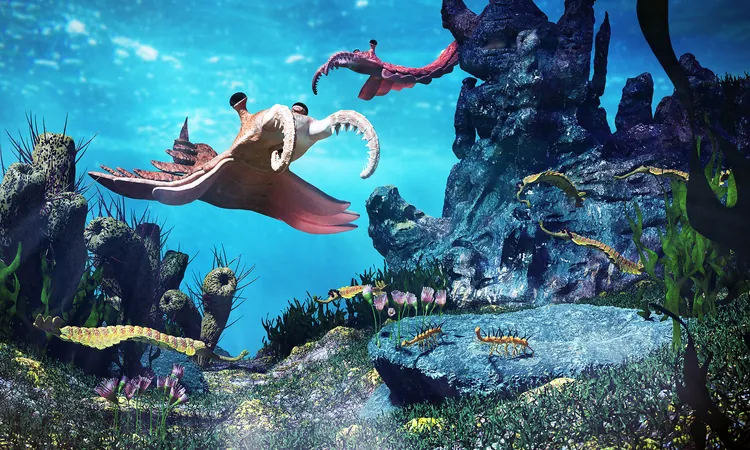
Ancient Fossil Discovery Unveils the Epic Battle Between Predators and Prey 517 Million Years Ago
2025-01-12
Author: Noah
Ancient Fossil Discovery Unveils the Epic Battle Between Predators and Prey 517 Million Years Ago
A groundbreaking examination of tiny Cambrian shell fossils has ignited excitement among paleontologists studying the transformative era when predator and prey dynamics began to shape marine life. This research, recently published in Current Biology, centers around shell fragments from a small creature that shares a lineage with modern brachiopods, unearthed from waters that once covered present-day South Australia.
The Cambrian period was a pivotal phase in Earth's history, beginning approximately 541 million years ago, marking the arrival of a vast array of life forms exhibiting shells, spines, and other protective adaptations. As mysteries lingered about the swift emergence of these protective features, scientists have sought to understand the factors driving such rapid evolutionary changes.
Were these advancements a direct response to predation, or were they an adaptation to environmental shifts? After decades of inquiry, the evidence now leans toward a narrative of intense interactions between predators and their prey.
Shell Damage: A Window into Ancient Predator-Prey Interactions
Leading the study, Russell Bicknell from the American Museum of Natural History, alongside colleagues from the University of New England and Macquarie University, focused their attention on the shell fossils of a Cambrian species named Lapworthella fasciculata. Among the numerous fragments ranging in size from a grain of sand to an apple seed, researchers identified over 200 shells with peculiar perforations suggestive of attacks from a worm-like or snail-like predator.
This analysis revealed that over time, the shells of L. fasciculata grew thicker and tougher, indicating an evolutionary arms race where prey continuously adapted defenses against escalating predation attempts.
A Rapid Evolutionary Arms Race
As Bicknell notes, "Predator-prey interactions are often cited as a crucial force behind the Cambrian explosion, yet empirical evidence of direct responses to predation was scarce." The newly discovered shell damage offers tangible proof of rapid adaptations, providing insights into the swift evolutionary tactics employed by these early marine organisms.
The study observes a stark increase in the frequency of shell punctures while simultaneously noting how shell-strengthening adaptations emerged within a remarkably short timeframe. L. fasciculata's evolution points to an urgent response mechanism to the predation pressures of its environment, hinting at a compelling narrative of survival and evolution in ancient seas.
The Larger Implications of These Findings
The implications of this research extend beyond just understanding ancient marine life. The evolutionary strategies observed in Cambrian organisms resonate with the survival tactics employed by modern shelled creatures. For instance, contemporary clams and snails continue to adapt their growth in response to current predatory threats, mirroring behaviors seen half a billion years ago.
As scientists unravel these ancient interactions, they uncover not only the biological responses of early marine communities but also draw connections to today’s ecosystems, where predator-prey dynamics remain a driving force in evolutionary biology.
Uncovering the Jurassic Puzzle
While the study provides a clearer narrative of predator-prey interactions during the Cambrian, it also sets the stage for future research that aims to unveil who exactly roamed these ancient waters and how they interacted. With more discoveries on the horizon, researchers are eager to piece together the puzzle of ancient marine life, revealing the complexities of evolution driven by survival instincts.
In essence, this study not only enhances our understanding of the Cambrian Explosion but reaffirms the timeless struggle for survival that has persisted through geological ages, reminding us that even 517 million years ago, the delicate balance of predator and prey was vital to the ocean's elaborate tapestry of life.









 Brasil (PT)
Brasil (PT)
 Canada (EN)
Canada (EN)
 Chile (ES)
Chile (ES)
 Česko (CS)
Česko (CS)
 대한민국 (KO)
대한민국 (KO)
 España (ES)
España (ES)
 France (FR)
France (FR)
 Hong Kong (EN)
Hong Kong (EN)
 Italia (IT)
Italia (IT)
 日本 (JA)
日本 (JA)
 Magyarország (HU)
Magyarország (HU)
 Norge (NO)
Norge (NO)
 Polska (PL)
Polska (PL)
 Schweiz (DE)
Schweiz (DE)
 Singapore (EN)
Singapore (EN)
 Sverige (SV)
Sverige (SV)
 Suomi (FI)
Suomi (FI)
 Türkiye (TR)
Türkiye (TR)
 الإمارات العربية المتحدة (AR)
الإمارات العربية المتحدة (AR)